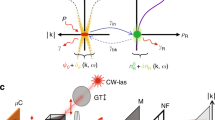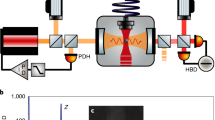Abstract
Exciton–polaritons in a microcavity are composite two-dimensional bosonic quasiparticles, arising from the strong coupling between confined light modes in a resonant planar optical cavity and excitonic transitions. Quantum phenomena such as Bose–Einstein condensation, superfluidity, quantized vortices, and macroscopic quantum states have been realized at temperatures from tens of kelvin up to room temperatures. Crucially, many of these effects of exciton–polaritons depend on the polariton–polariton interaction strength. Despite the importance of this parameter, it has been difficult to make an accurate experimental measurement, mostly because of the difficulty in determining the absolute densities of polaritons and bare excitons. Here we report a direct measurement of the polariton–polariton interaction strength in a very high-Q microcavity structure. By allowing polaritons to propagate over 20 μm to the centre of a laser-generated annular trap, we are able to separate the polariton–polariton interactions from polariton–exciton interactions. The interaction strength is deduced from the energy renormalization of the polariton dispersion as the polariton density is increased, using the polariton condensation as a benchmark for the density. We find that the interaction strength is about two orders of magnitude larger than previous theoretical estimates, putting polaritons in the strongly interacting regime.
This is a preview of subscription content, access via your institution
Access options
Access Nature and 54 other Nature Portfolio journals
Get Nature+, our best-value online-access subscription
$29.99 / 30 days
cancel any time
Subscribe to this journal
Receive 12 print issues and online access
$209.00 per year
only $17.42 per issue
Buy this article
- Purchase on Springer Link
- Instant access to full article PDF
Prices may be subject to local taxes which are calculated during checkout





Similar content being viewed by others
References
Kasprzak, J. et al. Bose–Einstein condensation of exciton polaritons. Nature 443, 409–414 (2006).
Balili, R., Hartwell, V., Snoke, D., Pfeiffer, L. & West, K. Bose–Einstein condensation of microcavity polaritons in a trap. Science 316, 1007–1010 (2007).
Amo, A. et al. Superfluidity of polaritons in semiconductor microcavities. Nat. Phys. 5, 805–810 (2009).
Lagoudakis, K. G. et al. Quantized vortices in an exciton–polariton condensate. Nat. Phys. 4, 706–710 (2008).
Lagoudakis, K. G. et al. Observation of half-quantum vortices in an exciton–polariton condensate. Science 326, 974–976 (2009).
Sanvitto, D. et al. Persistent currents and quantized vortices in a polariton superfluid. Nat. Phys. 6, 527–533 (2010).
Nardin, G. et al. Hydrodynamic nucleation of quantized vortex pairs in a polariton quantum fluid. Nat. Phys. 7, 635–641 (2011).
Tosi, G. et al. Geometrically locked vortex lattices in semiconductor quantum fluids. Nat. Commun. 3, 1243 (2012).
Dreismann, A. et al. Coupled counterrotating polariton condensates in optically defined annular potentials. Proc. Natl Acad. Sci. USA 111, 8770–8775 (2014).
Liu, G., Snoke, D. W., Daley, A., Pfeiffer, L. N. & West, K. A new type of half-quantum circulation in a macroscopic polariton spinor ring condensate. Proc. Natl Acad. Sci. USA 112, 2676–2681 (2015).
Christopoulos, S. et al. Room-temperature polariton lasing in semiconductor microcavities. Phys. Rev. Lett. 98, 126405 (2007).
Kena-Cohen, S. & Forrest, S. R. Room-temperature polariton lasing in an organic single-crystal microcavity. Nat. Photon. 4, 371–375 (2010).
Plumhof, J. D., Stoferle, T., Mai, L., Scherf, U. & Mahrt, R. F. Room-temperature Bose–Einstein condensation of cavity exciton–polaritons in a polymer. Nat. Mater. 13, 247–252 (2014).
Steger, M. et al. Long-range ballistic motion and coherent flow of long-lifetime polaritons. Phys. Rev. B 88, 235314 (2013).
Steger, M., Gautham, C., Snoke, D. W., Pfeiffer, L. & West, K. Slow reflection and two-photon generation of microcavity exciton–polaritons. Optica 2, 1–5 (2015).
Zhugayevych, A. & Tretiak, S. Theoretical description of structural and electronic properties of organic photovoltaic materials. Annu. Rev. Phys. Chem. 66, 305–330 (2015).
Snoke, D. in Exciton–Polaritons in Microcavities Vol. 172 (eds Timofeev, V. & Sanvitto, D.) (Springer Series in Solid State Sciences, Springer, 2012).
Tassone, F. & Yamamoto, Y. Exciton–exciton scattering dynamics in a semiconductor microcavity and stimulated scattering into polaritons. Phys. Rev. B 59, 10830–10842 (1999).
Prokof’ev, N., Ruebenacker, O. & Svistunov, B. Critical point of a weakly interacting two-dimensional Bose gas. Phys. Rev. Lett. 87, 270402 (2001).
Prokof’ev, N. & Svistunov, B. Two-dimensional weakly interacting Bose gas in the fluctuation region. Phys. Rev. A 66, 043608 (2002).
Amo, A. et al. Exciton–polariton spin switches. Nat. Photon. 4, 361–366 (2010).
Antón, C. et al. Optical control of spin textures in quasi-one-dimensional polariton condensates. Phys. Rev. B 91, 075305 (2015).
Sich, M. et al. Effects of spin-dependent interactions on polarization of bright polariton solitons. Phys. Rev. Lett. 112, 046403 (2014).
Sekretenko, A. V., Gavrilov, S. S. & Kulakovskii, V. D. Polariton–polariton interactions in microcavities under a resonant 10 to 100 picosecond pulse excitation. Phys. Rev. B 88, 195302 (2013).
Takemura, N., Trebaol, S., Wouters, M., Portella-Oberli, M. T. & Deveaud-Pledran, B. Heterodyne spectroscopy of polariton spinor interactions. Phys. Rev. B 90, 195307 (2014).
Wertz, E. et al. Spontaneous formation and optical manipulation of extended polariton condensates. Nat. Phys. 6, 860–864 (2010).
Tosi, G. et al. Sculpting oscillators with light within a nonlinear quantum fluid. Nat. Phys. 8, 190–194 (2012).
Cristofolini, P. et al. Optical superfluid phase transitions and trapping of polariton condensates. Phys. Rev. Lett. 110, 186403 (2013).
Askitopoulos, A. et al. Polariton condensation in an optically induced two-dimensional potential. Phys. Rev. B 88, 041308 (2013).
Askitopoulos, A. et al. Robust platform for engineering pure-quantum-state transitions in polariton condensates. Phys. Rev. B 92, 035305 (2015).
Sun, Y. et al. Bose–Einstein condensation of long-lifetime polaritons in thermal equilibrium. Phys. Rev. Lett. 118, 016602 (2017).
Sun, Y. et al. Stable switching among high-order modes in polariton condensates. Preprint at http://arXiv.org/abs/1602.03024 (2016).
Nelsen, B. et al. Dissipationless flow and sharp threshold of a polariton condensate with long lifetime. Phys. Rev. X 3, 041015 (2013).
Zimmermann, R. Dynamical T-matrix theory for high-density excitons in coupled quantum wells. Phys. Stat. Solidi. b 243, 2358–2362 (2006).
Ciuti, C., Savona, V. & Quattropani, A. Role of the exchange of carriers in elastic exciton–exciton scattering in quantum wells. Phys. Rev. B 58, 7926 (1998).
Pavlovic, G. Exciton–Polaritons in Low Dimensional Structures PhD thesis, Université Blaise Pascal - Clermont-Ferrand (2010).
Takemura, N., Trebaol, S., Wouters, M., Portella-Oberli, M. T. & Deveaud, B. Polaritonic feshbach resonance. Nat. Phys. 10, 500–504 (2014).
Marchetti, F. M., Keeling, J., Szymańska, M. H. & Littlewood, P. B. Thermodynamics and excitations of condensed polaritons in disordered microcavities. Phys. Rev. Lett. 96, 066405 (2006).
Marchetti, F. M., Keeling, J., Szymańska, M. H. & Littlewood, P. B. Absorption, photoluminescence, and resonant Rayleigh scattering probes of condensed microcavity polaritons. Phys. Rev. B 76, 115326 (2007).
Acknowledgements
We thank A. Daley and D. Pekker for fruitful discussions and J. Beaumarriage for assistance in the calibration of the detuning map of the sample. Y.S., Y.Y. and K.A.N. were supported as part of the Center for Excitonics, an Energy Frontier Research Center funded by the US Department of Energy, Office of Science, Office of Basic Energy Sciences under Award Number DE-SC0001088. M.S., G.L. and D.W.S. were supported by the National Science Foundation under grants PHY-1205762 and DMR-1104383. L.N.P. and K.W. were funded by the Gordon and Betty Moore Foundation through the EPiQS initiative Grant GBMF4420, and by the National Science Foundation MRSEC Grant DMR-1420541.
Author information
Authors and Affiliations
Contributions
Y.S. and D.W.S. designed the experiments; Y.S. performed the experiment; Y.S. and D.W.S. analysed the data; Y.S., Y.Y. and M.S. calibrated the detuning map of the sample; L.N.P. and K.W. grew the microcavity structure; all the authors participated in the discussion of the results and manuscript preparation.
Corresponding authors
Ethics declarations
Competing interests
The authors declare no competing financial interests.
Supplementary information
Supplementary information
Supplementary information (PDF 1289 kb)
Rights and permissions
About this article
Cite this article
Sun, Y., Yoon, Y., Steger, M. et al. Direct measurement of polariton–polariton interaction strength. Nature Phys 13, 870–875 (2017). https://doi.org/10.1038/nphys4148
Received:
Accepted:
Published:
Issue Date:
DOI: https://doi.org/10.1038/nphys4148
This article is cited by
-
Separating single- from multi-particle dynamics in nonlinear spectroscopy
Nature (2023)
-
Manipulating nonlinear exciton polaritons in an atomically-thin semiconductor with artificial potential landscapes
Light: Science & Applications (2023)
-
Ultrafast imaging of polariton propagation and interactions
Nature Communications (2023)
-
Monolayer tungsten disulfide in photonic environment: Angle-resolved weak and strong light-matter coupling
Nano Research (2022)
-
Mechanisms of blueshifts in organic polariton condensates
Communications Physics (2020)



